Geography - Seasons | 11th Geography : Chapter 2 : The Solar system and the Earth
Chapter: 11th Geography : Chapter 2 : The Solar system and the Earth
Seasons
Seasons
The seasons are caused due to the combined effect
of the earth’s revolution and the tilt of its axis in the same direction
throughout the year. In general, spring, summer, autumn and winter are the four
seasons (Figure 2.12). The latitude at which the sun appears directly overhead
changes as the earth orbits the sun. The sun appears to follow a yearly pattern
of northward and southward motion in the sky, known as the ‘apparent movement
of the sun’. It gives an impression that the sun is continuously swinging north
and south of the equator. Actually it is the earth that is moving around the
sun on its tilted axis. It varies when observed on a daily and monthly basis,
at different times of the year. On 21 March and 23 September the sun rises
precisely in the east and sets exactly in the west.
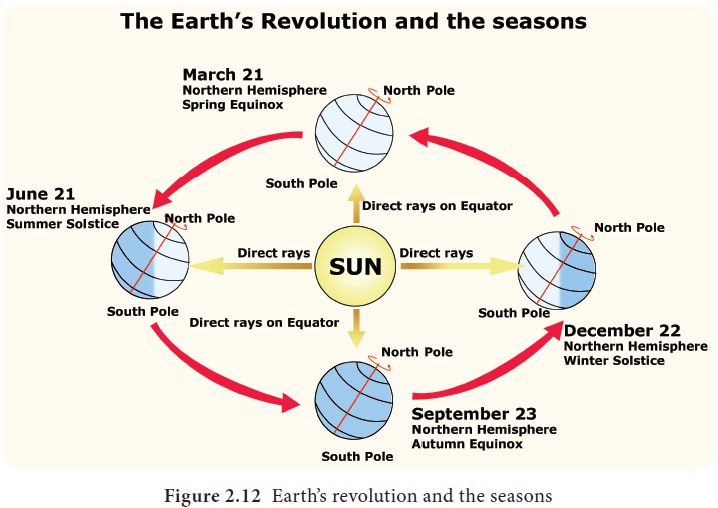
Equinoxes and solstices
You already knew that the sunrays are vertical at
noon. The vertical rays fall on a small area, giving more heat.
Equinoxes
Equinoxes occur when the earth reaches the points
in its orbits where the equatorial and the orbital planes intersect, causing
the sun to appear directly overhead at the equator. During the equinoxes the
periods of day light and darkness are equal all over the world. On 21 March the
sun is directly overhead at the equator. Throughout the world, on this day all
the places experience almost equal hours of day and night. This position of the
sun is called spring equinox. Again on 23 September the sun is directly
overhead on the equator and it is called autumn equinox.
Position of the earth on 21 March
Neither pole is inclined towards the sun. The rays
of the sun fall vertically on the equator. All the places have equal days and
nights as both the poles receive the rays of the sun. It is spring in the
northern hemisphere and autumn in the southern hemisphere. This day (21 March)
is known as spring equinox.
Position of the earth on 23 September.
Neither pole of the earth is inclined towards the
sun. The rays of the sun fall vertically on the equator. All the places have
equal days and nights. It is autumn in the northern hemisphere and spring in
the southern hemisphere. This day (23 September) when sun’s rays for fall
verticaly on the equator, is known as autumnal equinox (Figure 2.13).
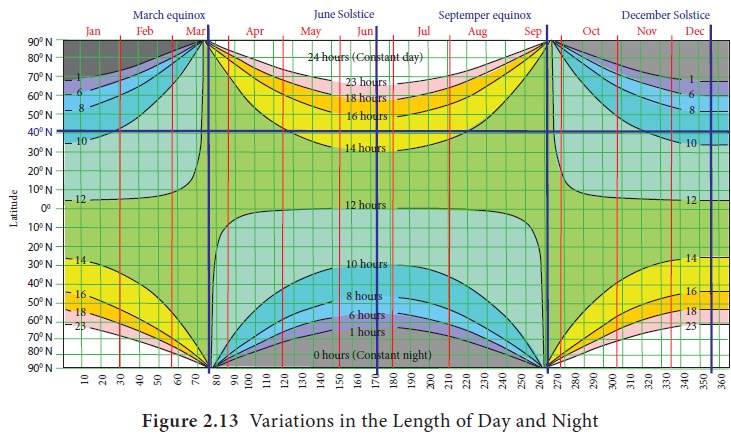
Position of the earth on 21 June
The North Pole is inclined or tilted towards the
sun. It, therefore, experiences complete light for 24 hours. The South Pole is
tilted away from the sun so it is in complete darkness for 24 hours. The rays
of the sun fall vertically at the tropic of cancer (23½º N). In the Northern
hemisphere, the days are longer than the nights (Table 2.2). It is summer in
the northern hemisphere and winter in the southern hemisphere. The day 21 June
is known as summer solstice.
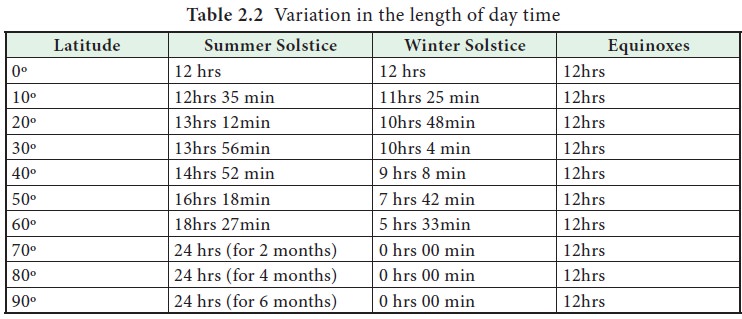
Position of the earth on 22 December
The South Pole is inclined towards the sun and the North Pole is away from it. The rays of the sun fall vertically at the tropic of Capricorn (23½º S). The greater part of the southern hemisphere gets the direct rays of the sun so the days are long and the nights are short here. In the northern hemisphere the nights are longer than the days at this time. The southern hemisphere has summer. The northern hemisphere has winter. This day (22 December), when the sun’s rays fall vertically on the Tropic of Capricorn, is known as winter solstice.
Eclipses
Let us understand the effect of the revolution of
the earth on the length of the days and the nights. The duration of the
daylight varies with latitude and seasons.
An eclipse is a complete or partial obscuration of
light from a celestial body and it passes through the shadow of another
celestial body. The eclipses are of two types. They are:
A) Solar Eclipse
It occurs on New Moon days, when the moon is
between the Sun and the Earth. Thus it obscures a part of the Sun viewed from
the Earth, but only from a small area of the world. It lasts only for a few
minutes. A partial solar eclipse
(Figure 2.14) happens when the moon partially covers the disc of the sun. An annular
solar eclipse occurs when the moon passes centrally across the solar disc.
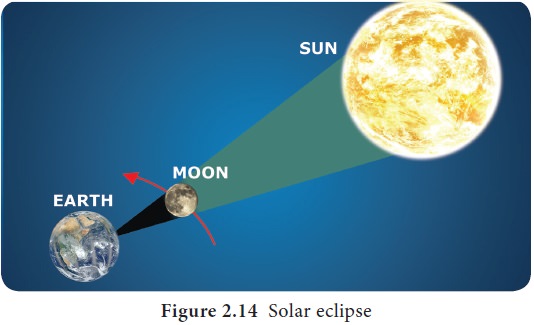
Fact
File
Geo
connects History
Secret
to Great Pyramid’s Near Perfect
Alignment Possibly Found!
The
Great Pyramid of Giza, 4,500 years ago, is an ancient feat of engineering. Now
an archaeologist has figured out how the Egyptians may have aligned the pyramid
almost perfectly along the cardinal points, north-south-east-west. Egyptians
may have used the autumn equinox. Methods used by the ancient Egyptians to align the pyramids along
the cardinal points are accurate.
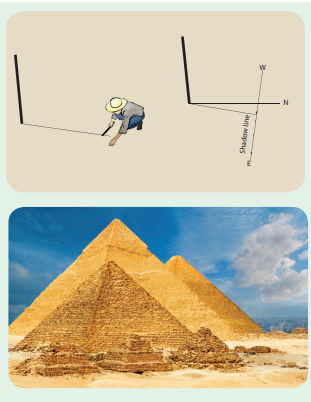
On the
day of the fall equinox, a surveyor placed a rod into the ground and tracked
its shadow throughout the day. The result was a line running almost perfectly
east-west. The Egyptians could have determined the day of the fall equinox by
counting forward 91 days after the summer solstice.
During a total
solar eclipse, the moon’s shadow is short enough to cover the whole sun.
The outer regions still glow and look bright as a ring. Such a phenomenon is
called Diamond Ring.
Lunar Eclipse
It occurs on a Full Moon position when the earth is
between the sun and the moon. The earth’s shadow obscures the moon as viewed
from the earth. A partial lunar eclipse can be observed when only a part of the moon’s surface is
obscured by earth’s umbra (Figure 2.15). A
penumbral lunar eclipse happens
when the moon travels through the
faint penumbral portion of the earth’s shadow. A total lunar eclipse occurs
when the earth umbra obscures the entire
the moon’s surface. Lunar eclipse can be seen from anywhere on the night side
of the Earth. It lasts for a few hours due to the smaller size of the moon.
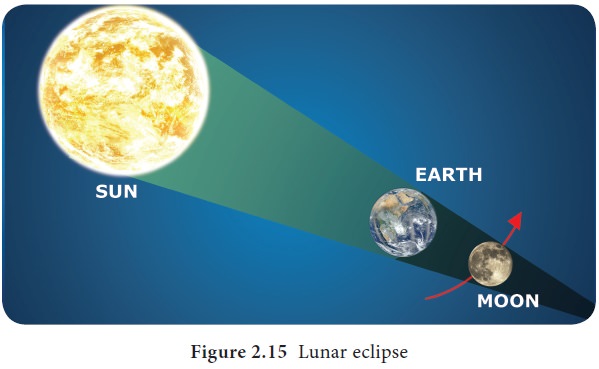
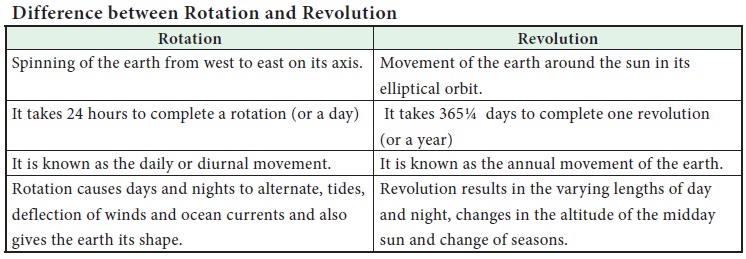
Phases of the Moon
The changing angles between the earth, the sun and
the moon determine the phases of the moon. Phases of the moon (Figure 2.16)
start from the ‘New Moon’ every
month. Then, only a part of the Moon is seen bright called ‘Crescent’, which develops into the ‘first quarter’. With the increasing brightness it turns into three
quarters known as ‘Gibbous’ and then
it becomes a ‘Full Moon’. These
stages are the waxing moon. After the full
moon, the moon starts waning or receding through the stages of Gibbous,
last quarter, crescent, and finally becomes invisible as dark New Moon.
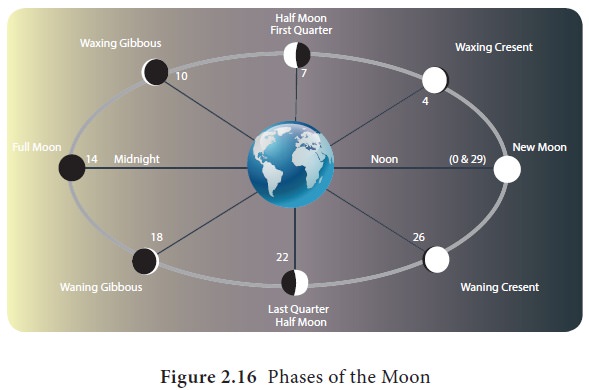
The varying lengths of daylight in different latitudes
It is evident from the table that the duration of
daylight is 12 hours throughout the year at the equator only. As one moves away
from the equator, the seasonal variations in the duration of daylight increase.
The seasonal variations in the duration of daylight are maximum at the polar
region.
Effects of the spherical shape of the earth
Variation in the amount of solar radiation
received:
If the earth were a flat surface, oriented at right
angle to the sun, all the places on the earth would have received the same
amount of radiation. But the earth is spherical/ geoid. Hence the sunrays do
not heat the higher latitudes of the earth as much as the tropics. On any given
day only the places located at particular latitude receive vertical rays from
the sun. As we move north or south of this location, the sun’s rays strike at
decreasing angles. The yearly fluctuations in the angle of the sun’s rays and
the length of the days change with the continual change of the earth’s position
in its orbit around the sun at an inclination of 66½ to the orbital plane.
Difference in the angle of the sun’s rays striking different parts of the earth.
Away from the equator, the sun’s rays strike the earth’s
surface at particular angle. The slanting rays are spread over a large area and
do not heat with the same intensity as the direct rays. As we go pole wards,
the rays spread over the regions beyond the Arctic and the Antarctic circles in
an extremely slanting manner. This is how we get the various temperature zones.
Lower the degree of latitude; higher the temperature. Not only that, the rays striking at a low angle must travel through a greater thickness of the atmosphere than the rays striking at a higher angle. The rays striking at a lower angle are subject to greater depletion by reflection and absorption by the atmosphere.
Temperature zones
The spherical shape of the earth along with its
movement around the sun causes differences in the angles at which the sun’s
rays fall on the earth’s surface. This causes a difference in the distribution
of heat on the earth’s surface.
As a result, the world has been divided into three
distinct heat zones or temperature zones. They are the Torrid zone, Temperate
zone and Frigid zone. You will learn more about it under the unit atmosphere.
Related Topics